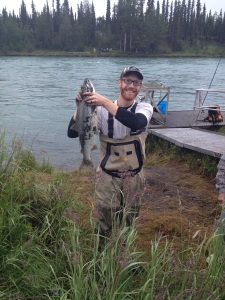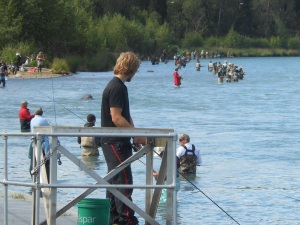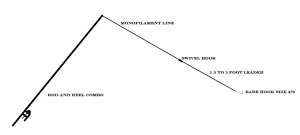 Alaska is known as the last frontier. In this majestic state you will find not only some of the most amazing mountains in the world, but some of the most abundant wildlife around. From moose that regularly come into the city of Anchorage, to the spawning salmon in the summer months, Alaska has something for all sportsmen. But it is one thing to know the wildlife is there, and quite another to actually be able to harvest it.
Alaska is known as the last frontier. In this majestic state you will find not only some of the most amazing mountains in the world, but some of the most abundant wildlife around. From moose that regularly come into the city of Anchorage, to the spawning salmon in the summer months, Alaska has something for all sportsmen. But it is one thing to know the wildlife is there, and quite another to actually be able to harvest it.
The Kenai River Spawn
From around the middle of July until the first week of August, the sockeye salmon (known locally as red salmon, or just “reds”) swim out of the ocean and up the Kenai River for their second (and larger) spawning run. During this time fishermen from all over the world flock to the river to catch these fish that are not only fun to reel in, but delicious to eat. From the dipnetters at the mouth of the river, to the combat fishing along the banks, salmon fishing is a popular sport during the long days of the Alaskan summer.
Fishing for Reds
 There are millions of people that know how to fish. They know that you tie on a lure, throw it out there, and reel it back in. Many people understand the concepts of cast and retrieve, and they even know when you should use a lure and when you should use live bait. All of these concepts are thrown out when it comes to fishing for red salmon on the Kenai River.
There are millions of people that know how to fish. They know that you tie on a lure, throw it out there, and reel it back in. Many people understand the concepts of cast and retrieve, and they even know when you should use a lure and when you should use live bait. All of these concepts are thrown out when it comes to fishing for red salmon on the Kenai River.
Before we even start to fish, we need to understand how these fish are moving up the stream.
Spawning Red Salmon
When the reds begin to spawn, all common sense flies out the window. Their minds are programmed for one thing only: procreation. They are not worried about avoiding dangers, eating, or sleeping. The only thing they want to do is get upstream in order to lay or fertilize eggs. This makes for some unique fishing on the part of the angler.
The red salmon will spawn upstream following the path of least resistance. This means they stick fairly close to shore (while they are ignoring most dangers, they certainly have not lost ALL their senses. They will stay just out of harm’s way) where the water is not moving quite as fast as the middle of the river.
While spawning the fish don’t eat. However, in order to breathe they are still opening and closing their mouths as they swim along near the bottom of the river. Their location in the river, combined with their natural mouthing action, allows them to be fished heavily and easily.
Setting Up Your Line
Before we head out to fish we need to make sure we have the proper setup. Most of the fish have an average size of 6 – 9 pounds, but it is not uncommon to reel in a 12+ pounder. Accompany this with the fact they can tend to fight fiercely, or the fact that you might hook into a larger fish of a different species, and you will see the need to string your reel with 30 pound monofilament line(you can use braided line, but mono is a little easier to work with), and set that onto a heavy duty pole.
Once you have your line strung, you can build a leader. At the end of your line, attach a one ounce weight (this may vary depending on where you are). I prefer this style as it incorporates the weight and the swivel into one. After the swivel weight, you will want 1.5 to 5 feet of line with a size 4/0 hook tied to the end (edit: many use a safer and smaller 2/0 hook). Some people prefer a coho fly, but a bare hook will sink faster. Unless you are fishing in an area that has specific regulations (like on the Russian River), then a bare hook works just fine.
Confused about the setup? Here’s a quick diagram:
Catching Red Salmon
With the rod and reel all set up, we can now go and actually catch some fish. There are many different public access points along the Kenai River, and some will be better than others. Be sure to bring plenty of cash, as you may need to pay for parking.
After you have located a good spot, wade about knee deep into the water. With your leader securely tied on, “cast” upstream and let out 10 to 15 feet of line. Since you are not throwing the line out there very far most people don’t even bother casting, but rather just flip the line out. You will want throw it at about a 45 degree angle from the shore.
As the current brings the weight and hook downstream you will feel it strike bottom when everything is directly in front of you. At this point prepare your hands, and give the line a quick jerk back toward you. If you don’t snag into a fish, repeat the process. Here is a quick diagram of the process:
The idea here is that the weight will hit first, and the lighter hook will keep extended. Since so many fish are swimming upstream, there is a very high chance the line from your leader will end up in one of their mouths. The quick jerk will draw the line through, and the hook will snag the fish. If you get one on, and there are people nearby, shout “fish on!” to alert others you may be invading their space. Then keep the tension on as you bring the fish into the shore. A net is extremely helpful.
If you did not snag the red salmon in the mouth, you cannot keep it. Carefully remove the hook and release it into the water. But if you did snag in the mouth, get it out of the water quickly with the help of a net, then bonk it on the head. This will knock it out or kill it and let you get it onto a stringer. Your red salmon limit is 3 daily, and 3 in possession (although during a large run the fish and game could up that to 6) that are not frozen. So if you hit your limit in the morning, filet them out, vacuum seal them, and freeze them and then your possession limit starts over (keep in mind you have to wait until the next day as your daily limit does not start over).
If You Go
 A fishing trip to Alaska is an amazing adventure. Not only are the views incredible, but the fishing is easy… provided you know what to do. This quick summary should get you well on your way to pulling in fish after fish, but keep in mind it varies a little with each area. Ask those nearby how long of a leader they are using, and follow suit. There are also better times to fish than others, and many people find early morning or late evening is when they catch the most. So get out there, have a lot of fun, and take home some delicious, and protein rich, red salmon.
A fishing trip to Alaska is an amazing adventure. Not only are the views incredible, but the fishing is easy… provided you know what to do. This quick summary should get you well on your way to pulling in fish after fish, but keep in mind it varies a little with each area. Ask those nearby how long of a leader they are using, and follow suit. There are also better times to fish than others, and many people find early morning or late evening is when they catch the most. So get out there, have a lot of fun, and take home some delicious, and protein rich, red salmon.


